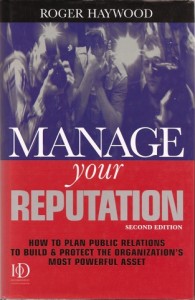The one-sentence summary
All organizations must behave impeccably and manage their public relations with intelligence if they are to safeguard their reputation.
- It tells clients and people in PR agencies how to plan public relations to build and protect the organisation’s most powerful asset – its reputation
- It outlines the basic principles of PR, how the direction must be set from the top, and how to design and measure every type of programme
- It argues that the attitude of someone taking a decision can be more important than the logical elements
- A spontaneous reaction to your company or brand (the “Pub Test”) can be a decent measure of public relations
- The best corporate behaviour is likely to be the most profitable
WHAT’S GOOD ABOUT IT
- Asserting that company or brand reputation is everyone’s responsibility might enable you to start deeper strategic conversations with your clients
- Every practitioner’s element to plan a good PR programme is here: developing the brief, writing the plan, and measurement. There are whole chapters on public affairs, corporate and investor relations, issues and crisis planning
- There is a section on how to develop an effective PR structure which summarises the thinking of all the industry bodies
- There is also one on how clients should choose agencies, which should certainly be read as a reminder before any pitch or re-pitch
- A number of the sub-heads can easily be extracted as good material for presentations. For example: Choose your words carefully, Understand the other point of view, Encourage advice you do not want to hear, You learn nothing when you are talking and Consider the journalist’s point of view
- There is a good distinction drawn between an aim (a direction in which progress is to be made) and an objective (a specific point to be reached)
WHAT YOU HAVE TO WATCH
- Compared to most modern books it is a bit dry, so you are best off lifting out the chunks that suit your particular needs, rather than reading it end to end
- There is no revolutionary thinking here – it is more like a textbook of good practice
- Most of it is more relevant to corporate PR than it is to consumer, technology or healthcare brands, so care needs to be taken when applying the thinking

